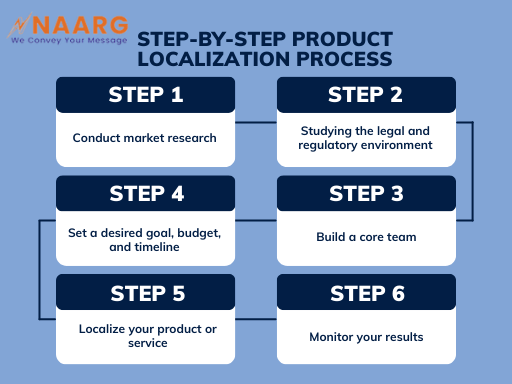When we talk about product localization, we mostly see it in connection with apps or software, but in reality, it can be anything at all. Product localization can be done even for non-software projects in the form of user manuals, educational platforms, and customer service platforms. The ultimate goal of product localization is to localize your product in a way that it feels as if it was designed specifically for that target market.
This specific localization process will help you expand into new markets. It is a unique localization process and requires a continuous approach. For this approach, you require a dedicated project management team and localization team that support this localization process. Did you know that 84% of global marketers say that the localization process has had a positive impact on the revenue growth of their businesses?
Want to learn about product localization? In this blog post, we will walk you through the components of product localization and its benefits. And the top tools used for product localization.
So let’s get started.

What is Product Localization?
Product localization is the process of adapting a product or service to the native language and culture of customers in a specific country or target market. And when we say localizing a product, it includes everything.
From translating user interface elements and technical documents to localizing mobile apps and marketing materials. The goal of this localization process is to ensure that your product or service feels native and resonates with your potential customers, fostering a sense of familiarity and connection.
While you must associate product localization with translation, product localization encompasses a broader spectrum of adjustments, which includes cultural references, design elements, legal compliance, and even the overall user experience.
Successful product localization involves a deeper understanding of the target market’s cultural, social, and economic dynamics. Hence ensuring that the offering not only meets functional requirements but also resonates on an emotional level.
By embracing this localization process, your business can break down barriers, connect with a diverse consumer base, and establish a global presence that goes beyond geographic boundaries.
Key Components of Product Localization
As you know, localization involves the process of adapting a product or service to meet the cultural, linguistic, and functional needs of your target market.
So, some of the essential components of this product localization include:
1. Language and Content Localization
For this, you need to translate all written content, including product descriptions, user manuals, and even marketing materials, into the native language of your potential customers. It is necessary to adapt your content in a way that cultural nuances, idioms, and regional variations are thoroughly considered.
2. User Interface and User Experience Localization
Always adjust your user interface elements, such as buttons, menus, and labels, to match the local language and cultural expectations. And ensure that the overall user experience aligns with local preferences and expectations.
3. Legal and Regulatory Compliance
It is an essential step in your localization efforts. And that is to ensure that the product complies with local laws, regulations, and standards. Always adapt the terms and conditions, privacy policies, and legal documentation to align with local requirements to expand into new markets.
4. Numeric, Date, and Time Formats
When you opt for the localization process, it is essential to adjust formats for numbers, dates, and times to match local conventions. Also, consider variations in units of measurement and currency symbols.
For an effective localization process, it is essential to take a holistic approach. Taking into account not only language translation but also a deep understanding of the target market’s culture, preferences, and regulatory environment.
Benefits of Product Localization
If you are going for product localization to expand into new markets for your business, then you are on the right track. It will offer several benefits for your business to reach the global market. Here are some key benefits of product localization.
1. Increased Trust
Once you localize your product or service according to your target market. Through this localization process, you will be perceived as a brand that shows respect for other cultures. According to CSA research, 65% of people prefer content in their native language, even if it is of poor quality.
You can conveniently gain genuine trust from your target audience through cultural adaptation. In turn, you will receive their trust, which will lead to important retention like higher sales, higher customer satisfaction, and an excellent customer experience.
2. Stronger Brand Consistency
Localizing your product for your global market gives you full control over the message of your brand and also delivers a consistent brand experience across all target markets. With localization efforts, it is easier to ensure your brand messaging is being communicated as you intend, rather than miscommunicated.
Because localization ensures that your product is not only translated but also accounts for the cultural and personal preferences of each location, This will ensure brand consistency and a better brand image.
3. Competitive Advantage
With these localization efforts, your business will gain a competitive advantage over those that offer one-size-fits-all solutions. And why is that? Because a localized product demonstrates a commitment to understanding and meeting the specific needs of diverse markets.
Overall, you can say that this localization process is not only a strategic move for reaching new markets but also a means of building stronger relationships with your potential customers. Hence, fostering brand loyalty and driving business growth on a global scale.

Step-by-Step Product Localization Process
This localization process involves several steps to ensure a comprehensive and effective adaptation of a product for a specific target market. Here is a step-by-step guide for you.
1. Conduct Market Research
The first step in your product localization process is to conduct in-depth market research. The team for the localization process should get a clear picture of the target market. Their language, culture, and social norms.
And how these factors relate to the type of product or service your company wants to sell in the target market. For comprehensive market research, it is essential to analyze competing offerings to understand the marketing tactics that are proving successful in the desired target market.
2. Studying the Legal and Regulatory Environment
When you enter a new market, you should develop a good knowledge of what laws and regulations are there when it comes to producing, distributing, and advertising your products. Because every target market has some limitations.
And due to this, your product may get banned in the new target market. Advertising practices might also vary from country to country. For instance, certain health products are allowed with only specific disclaimers in some countries. These are the requirements you need to consider for the localization process of your product or service.
3. Build a Core Team
Create a compelling project management team for your localization strategy. This requires a multidisciplinary team with expertise in different areas. The team should comprise people who bring together translation, marketing, and technical skills.
With a strong knowledge of the local market, culture, and language. Once you establish this core team, you can create a comprehensive plan covering all aspects of your localization process.
4. Set a Desired Goal, Budget, and Timeline
Before starting your localization process, you should get a clear understanding of your goals and objectives. What are the goals you are trying to achieve in the foreign market?
Does your budget allow you to launch this localization effort? What is the ROI you want to expect from this localization effort? All these should be considered and clearly defined to achieve the desired goal. You should define a proper budget and timeline for your product localization efforts.
5. Localize your Product or Service
Once you have successfully established a core team, completed your market research, and set your goals, budget, and timeline. It’s time to proceed with the actual location process for your products and services.
Now, this involves adapting your product or service in line with local customer requirements. You should iterate and make necessary changes based on user feedback to enhance your product’s alignment with local preferences.
6. Monitor Your Results
For the final step, you should monitor the results of your localization efforts. This step involves tracking user engagement, customer feedback, and key performance indicators to assess the success of your localization efforts.
By using this information, you can adjust your strategy if necessary and ensure your localized product or service meets the needs of your target audience.
Top Tools for Product Localization
The localization process involves various aspects, including language translation, user interface adjustments, and cultural adaptation. Several tools are available to streamline the product localization process. Here are some of the top tools for product localization:
1. Smartling
It is a cloud-based translation management system that helps manage your translation workflows, automate content delivery, and collaborate with translators.
2. SDL Trados Studio
It is a popular CAT tool that assists translators with translation memory, terminology management, and quality assurance. Hence, improving consistency across content.
3. Crowdin’
It is a cloud-based localization platform that facilitates collaboration among translation teams, automates workflows and easily integrates with various development environments.
Integrating these tools effectively in your product localization process can significantly improve efficiency and accuracy throughout the localization process lifecycle. Selecting the right combination of these tools depends on the specific requirements of your localization process.
Contact us today to know more about our localization process.

